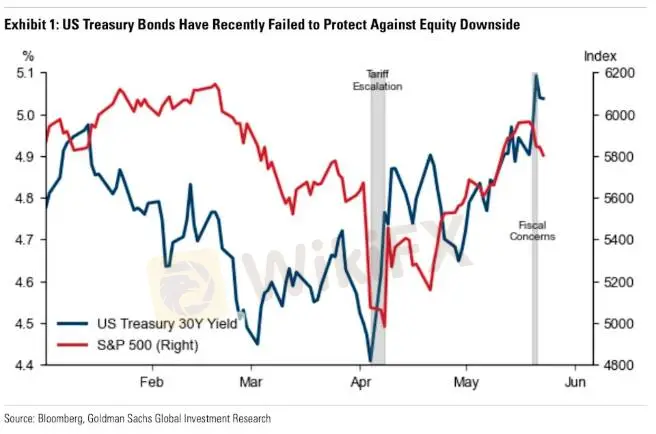简体中文
繁體中文
English
Pусский
日本語
ภาษาไทย
Tiếng Việt
Bahasa Indonesia
Español
हिन्दी
Filippiiniläinen
Français
Deutsch
Português
Türkçe
한국어
العربية
【MACRO Alert】Asset allocation shift under the failure of traditional 60/40 portfolio: the struggle b
Abstract:The Dilemma of Traditional Stock-Bond Portfolios and the Rise of Alternative AssetsIn recent years, the traditional 60/40 investment portfolio that focuses on stocks and bonds has gradually become ine
The Dilemma of Traditional Stock-Bond Portfolios and the Rise of Alternative Assets
In recent years, the traditional 60/40 investment portfolio that focuses on stocks and bonds has gradually become ineffective under the impact of tariff policies and economic uncertainty. Goldman Sachs pointed out that long-term US Treasury bonds have failed to play a role in hedging the downside risks of the stock market recently. Whether it is the recession concerns caused by the tariff escalation in April or the surge in borrowing costs caused by fiscal sustainability concerns in May, US Treasury bonds have not reflected their safe-haven value. This phenomenon is not accidental. In history, during periods of inflation or commodity shocks, the stock and bond markets often fall simultaneously.

Bitcoin's substitution effect on gold and market differentiation
At the same time, there is a clear fund rotation in the US ETF market: investors are turning from gold to Bitcoin. In the past five weeks, US Bitcoin ETFs have attracted more than $9 billion in inflows, with IBIT under BlackRock taking the lead, while gold ETFs have seen outflows of more than $2.8 billion during the same period. This phenomenon is due to two factors:
l Changes in the macro environment: The easing of trade tensions has weakened the safe-haven demand for gold, while concerns about US fiscal stability (such as Moody's downgrading the US credit rating to non-AAA) have driven the recognition of Bitcoin as "digital gold". Bitcoin recently broke through $110,000 to a record high, partly due to regulatory benefits such as the progress of the stablecoin bill, and the demand for value storage brought about by macro uncertainties.
l Controversy over asset attributes: Although gold has still risen by 25% this year (higher than Bitcoin's 15%), its short-term performance has fallen from its peak, while Bitcoin is trying to get rid of the label of "tech risk asset". Pepperstone research shows that the correlation between Bitcoin and Nasdaq, the US dollar and even gold has dropped significantly in the past month, and it is gradually being regarded as an independent hedging tool. Standard Chartered Bank pointed out that Bitcoin works through the dual paths of "hedging private sector risks" (such as banking crises) and "government agency risks" (such as concerns about the stability of national debt), and its decentralized nature makes it more advantageous in hedging financial system risks.

Asset allocation logic under macro risks
The core contradiction in the current market lies in the competition for the positioning of traditional safe-haven assets (gold) and emerging digital assets (Bitcoin). The differences between Goldman Sachs and Standard Chartered and other institutions reflect the differences in investors' judgments on "risk types":
l Advantageous scenarios for gold: In geopolitical conflicts, when local wars or international tensions escalate, market risk aversion rises sharply, and gold, as a "safe-haven asset in troubled times," tends to rise rapidly in value; if the central bank's monetary policy becomes disordered, such as excessive money issuance causing inflation expectations to get out of control, or frequent changes in the direction of monetary policy lead to confusion in market expectations, gold's anti-inflation and value-preserving properties will become prominent.
l Bitcoin's advantageous scenarios: In the face of a fiscal credit crisis, when government debt is high and sovereign credit ratings are downgraded, investors' confidence in traditional legal currencies is shaken. Bitcoin's decentralized and constant total volume characteristics make it a potential safe haven for funds. If there are stability concerns in the financial system, such as bank runs and exposure to systemic financial risks, Bitcoin, as a digital asset independent of traditional financial institutions, can provide investors with alternative allocation options.

For investors, asset allocation strategies need to deeply integrate holding periods and risk preferences to build differentiated solutions:
l Long-term investors: It is recommended to use gold as a core safe-haven asset. Based on its millennial currency attributes and its value-preserving characteristics in low inflation periods, a 10%-15% position can be allocated.
l Short-term traders: Although cryptocurrencies such as Bitcoin have high elasticity, a strict risk management system needs to be established.
Regardless of the strategy adopted, asset allocation in the post-60/40 era needs to build a hedging matrix across asset classes: hedge inflation risk through commodity futures, use treasury futures to respond to monetary policy shifts, and allocate emerging market bonds to mitigate sovereign debt crises, ultimately forming a three-dimensional protection system that can withstand multiple macro risks (inflation, policy, debt).
Disclaimer:
The views in this article only represent the author's personal views, and do not constitute investment advice on this platform. This platform does not guarantee the accuracy, completeness and timeliness of the information in the article, and will not be liable for any loss caused by the use of or reliance on the information in the article.
WikiFX Broker
Latest News
Top Wall Street analysts are upbeat about these dividend-paying stocks
Singapore's economy grows 4.3% in second quarter, beating expectations
In middle of Trump's trade war, importers hold more cash and move inventory off the books
Asia-Pacific markets trade mixed as investors assess Trump's latest tariff threats; bitcoin hits new highs
Gold Soars Above $3,350 as XAU/USD Rallies on Trade Tensions
What WikiFX Found When It Looked Into Emar Markets
Short or Long Term: Which to Choose for Double-Digit Returns from Gold Investments?
What is Forex Trading Simulator?
MT4 vs MT5 Which Forex Trading Platform Fits Your Needs in 2025?
Stock futures slide on more Trump tariff letters, but are off worst levels of session: Live updates
Currency Calculator


